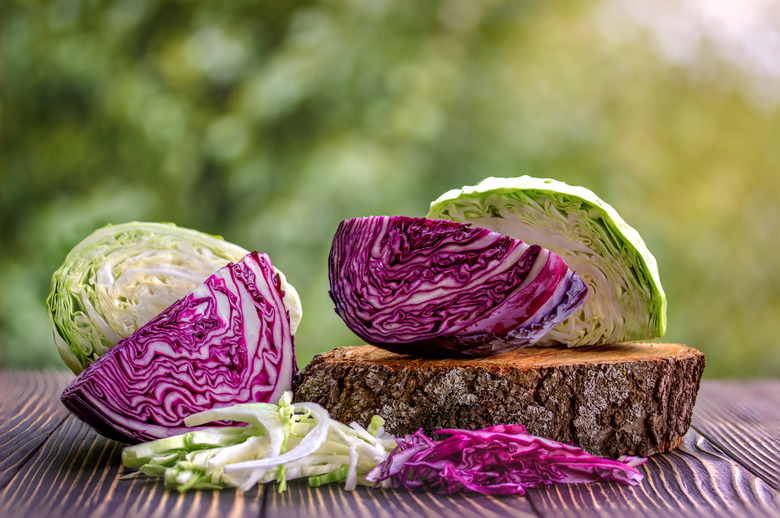Chemistry Science Fair Projects
Chemistry-focused science fair projects are ways for students of any age to showcase their scientific knowledge. With a chemistry science fair project, students learn about and observe chemical processes in real time while also learning how to record the results of experiments and present them to an audience. Elementary school students can conduct simple experiments with harmless chemicals found in their own homes, while middle school and high school students may choose to work with chemicals that are more volatile or difficult to find. For example, elementary school students can make a color-changing liquid from cabbage. Middle school students can boil common household beverages to determine their sugar content, and high school students can test how well different substances ferment yeast.
TL;DR (Too Long; Didn't Read)
Chemistry science fair projects showcase the scientific knowledge of students from elementary school to high school. For example, elementary school students can use cabbage juice to make a color-changing liquid, middle school students can boil different beverages to determine their sugar content, and high school students can test the efficiency with which different substances ferment yeast.
Color-Changing Cabbage Project
Color-Changing Cabbage Project
The objective of color-changing cabbage project is to determine the pH of a homemade liquid by watching it change color. This project works well for young science fair participants, such as those in elementary school. For this project, students need a small red cabbage, a strainer, a pot of boiling water, white paper cups, a medicine dropper, two large bowls and a variety of household liquids. These liquids can include fruit juice, soda, vinegar, baking soda solution or household cleaners, although safety equipment, such as rubber gloves, should be used when working with harsh cleaners. This project requires adult supervision and assistance.
1. Grate the cabbage into a bowl and pour in boiling water until the cabbage pieces are completely covered. Stir the solution and leave it until it reaches room temperature.
2. Remove the cabbage pieces from the mixture using a strainer. The purplish liquid left behind changes color depending on its pH. To change the pH, students add household liquids to it.
3. In white paper cups, pour equal amounts of the cabbage solution and then add a different household liquid to each cup.
Students can record their findings and use a pH chart (see Resources) to figure out how each household liquid changes the cabbage liquid's pH. They can then present these findings along with a display as part of the project. Samples of the different-colored liquids may be used as part of the display as well, as long as they are kept in sealed containers.
Comparing Sugar-Content Project
Comparing Sugar-Content Project
This chemistry-focused science project regarding sugar content uses safe, easy-to-find materials, but it requires careful weighing and recording of data, which makes it perfect for middle school students. The objective of this project is to figure out the sugar content of common beverages by weighing the sugar in each. Because it involves boiling water, students may need adult supervision. For this project, students need a pot, a stove, a scale, fruit juice, soda, and any other household beverage that contains sugar, such as flavored water or artificially flavored mixed juices.
1. Weigh the empty pot.
2. In the pot, pour the first beverage.
3. Boil the pot until all the liquid dissipates, leaving only the sugar.
4. Weigh the pot with the sugar, subtract the weight of the empty pot, and record the result, which is the weight of the sugar alone.
Repeat this process for each beverage and create a chart of the findings. The results of this experiment can be presented as a science project along with a display.
Fermenting Yeast Project
Fermenting Yeast Project
The purpose of the fermenting yeast project is to determine how efficiently polysaccharides ferment yeast. Because the project requires the use of specialized equipment and the use of chemicals that need to be special ordered by the student or the student's school, this project is best completed by experienced high school students. For this project, students need droppers, graduated cylinders, test tubes, three volumetric flasks, cellulose, maltose, sucrose and yeast.
The procedure for this project is complex.
1. Begin by making 1-molar solutions of cellulose, maltose and sucrose. (See Resources for more information on making molar solutions.)
2. Transfer each solution to a 1-meter volumetric flask and dissolve each one in 800 mL of distilled water.
3. When the solution is dissolved, add 200 mL of additional distilled water.
4. Measure 5 grams of yeast onto a tray. Transfer the yeast to the removed rubber end of a dropper and place the rubber end back on the dropper, while keeping the dropper inverted. Place the inverted dropper inside a test tube.
5. Fill the test tube with tepid water and add 4 mL of the 1-molar cellulose solution to the inside of the dropper.
6. Record the number of carbon dioxide bubbles that come out of the rubber end of the dropper. Repeat this process using the maltose and sucrose solutions.
The carbon dioxide bubbles are an indicator of how fast the yeast is fermenting. The more bubbles there are, the more quickly it is fermenting.
Record these results in an easy-to-read chart or graph and present it along with visual aids as a science fair project. An explanation of the basic fermentation process and photographs of the experiment itself enhance audience understanding.
Cite This Article
MLA
Cook, Maria. "Chemistry Science Fair Projects" sciencing.com, https://www.sciencing.com/chemistry-science-fair-projects-13710538/. 27 March 2018.
APA
Cook, Maria. (2018, March 27). Chemistry Science Fair Projects. sciencing.com. Retrieved from https://www.sciencing.com/chemistry-science-fair-projects-13710538/
Chicago
Cook, Maria. Chemistry Science Fair Projects last modified August 30, 2022. https://www.sciencing.com/chemistry-science-fair-projects-13710538/
